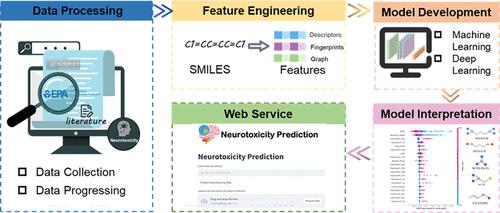环境相关化合物神经毒性预测的可解释机器学习模型的开发
IF 11.3
1区 环境科学与生态学
Q1 ENGINEERING, ENVIRONMENTAL
引用次数: 0
摘要
神经系统疾病患病率的上升已成为一项重大的全球健康挑战,环境污染物被确定为主要贡献者。然而,大量的环境相关化合物,加上传统方法的低效率,导致神经毒性数据存在很大的空白。在这项研究中,我们使用高质量的数据集开发了一个健壮且可解释的神经毒性预测模型。为了确定最佳的预测模型,我们对三种分子表示方法(分子指纹、分子描述符和分子图)、六种传统机器学习(ML)算法和两种深度学习(DL)方法进行了评估。最优模型将分子指纹和描述符与极端梯度增强(XGBoost)相结合,训练精度为0.93,曲线下面积(AUC)为0.99,优于其他ML和DL模型,同时保持了可解释性。该模型用于筛选人体血液中检测到的1170种化合物,成功预测了1145种。在已知神经毒性数据的89种化合物中,该模型的准确度为0.74。它确定了821种潜在的神经毒性化合物,其中36种具有高检测浓度,值得进一步研究。开发了一个在线平台(http://www.envwind.site/tools.html)以扩大可访问性。该模型为预测神经毒性和管理环境健康风险提供了有效的工具。本文章由计算机程序翻译,如有差异,请以英文原文为准。

Development of an Interpretable Machine Learning Model for Neurotoxicity Prediction of Environmentally Related Compounds
The rising prevalence of nervous system disorders has become a significant global health challenge, with environmental pollutants identified as key contributors. However, the large number of environmental related compounds, combined with the low efficiency of traditional methods, has resulted in substantial gaps in neurotoxicity data. In this study, we developed a robust and interpretable neurotoxicity prediction model using a high-quality data set. To identify the best predictive model, three molecular representation methods (molecular fingerprints, molecular descriptors, and molecular graphs) combined with six traditional machine learning (ML) algorithms and two deep learning (DL) approaches were evaluated. The optimal model, combining molecular fingerprints and descriptors with eXtreme Gradient Boosting (XGBoost), achieved a training accuracy of 0.93 and an area under the curve (AUC) of 0.99, outperforming other ML and DL models, while maintaining interpretability. The model was used to screen 1170 compounds detected in human blood, predicting 1145 successfully. Among 89 compounds with known neurotoxicity data, the model achieved an accuracy of 0.74. It identified 821 potentially neurotoxic compounds, including 36 with high detection concentrations, warranting further study. An online platform (http://www.envwind.site/tools.html) was developed to expand accessibility. This model offers an efficient tool for predicting neurotoxicity and managing environmental health risks.
求助全文
通过发布文献求助,成功后即可免费获取论文全文。
去求助
来源期刊

环境科学与技术
环境科学-工程:环境
CiteScore
17.50
自引率
9.60%
发文量
12359
审稿时长
2.8 months
期刊介绍:
Environmental Science & Technology (ES&T) is a co-sponsored academic and technical magazine by the Hubei Provincial Environmental Protection Bureau and the Hubei Provincial Academy of Environmental Sciences.
Environmental Science & Technology (ES&T) holds the status of Chinese core journals, scientific papers source journals of China, Chinese Science Citation Database source journals, and Chinese Academic Journal Comprehensive Evaluation Database source journals. This publication focuses on the academic field of environmental protection, featuring articles related to environmental protection and technical advancements.
 求助内容:
求助内容: 应助结果提醒方式:
应助结果提醒方式:


